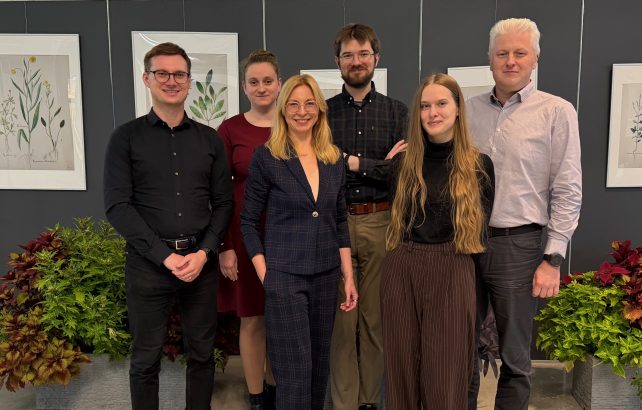A Study on DNA Sensors by VU Life Sciences Center Researchers Featured on the Prestigious ACS Sensors Cover

Researchers at the Life Sciences Center of Vilnius University (VU) have gained international recognition, with their study published in the prestigious journal ACS Sensors, and the accompanying illustration chosen to feature on its cover. The team developed electrochemical biosensors capable of reliably detecting single-nucleotide polymorphisms (SNPs) in human saliva – subtle but crucial genetic variations that can influence individual differences, such as disease susceptibility, drug efficacy, or side effects.
‘The idea for creating DNA sensors arose from our two areas of interest – fundamental studies of electron transfer between DNA and surfaces and applying this knowledge to genotyping real samples,’ explained Dr Dalius Ratautas, the project lead and researcher at the Institute of Biochemistry of the VU Life Sciences Center.
The research initiated by Dr Ratautas and his colleagues received funding through the field-initiated projects programme of the Research Council of Lithuania. The project has resulted in a technology that enables genetic analysis to be performed quickly, affordably, and conveniently in clinical practice. According to Dr Ratautas, studies like this are crucial because cardiologists increasingly recommend such analyses to tailor treatments to individual patients.
In international research, demonstrating that a sensor works in simple, specially prepared solutions is no longer sufficient. Achieving a high level of applicability requires testing with real samples similar to those used in practice. In their study, the team focused on the CYP2C19 gene, which determines how our body metabolises certain medications. Two variants were analysed: the wild-type and the CYP2C19*17, which exhibits higher-than-usual-activity. Each person carries this gene and produces the corresponding enzyme called CYP2C19 oxidase.
The research showed that analysing CYP2C19 from real saliva samples proved challenging. PCR methods used in DNA research often yield DNA strands that are longer than desired, thereby requiring sensor optimisation. The double-stranded structure of DNA also complicates probe binding, and samples typically contain insufficient genetic material, so amplification is necessary,’ said Dr Ratautas.
To address these challenges, the team applied a simple DNA preparation method developed together with scientists from the Institute of Biotechnology at the VU Life Sciences Center: a saliva sample is amplified using a special PCR technique, and without conducting any additional purification, it is immediately applied to the electrochemical sensor. Such a system can reliably determine a person’s genetic information in about 60 minutes, distinguishing between a normal gene, a heterozygous variant, or a homozygous SNP variant. ‘I am delighted that we combined different scientific competencies toward a common goal – a step closer to personalised medicine in everyday practice,’ remarked Dr Miglė Tomkuvienė from the Institute of Biotechnology of the VU Life Sciences Center.
According to Dr Skomantas Serapinas, a PhD student at the Institute of Biochemistry and first author of the paper, such sensors are of great importance due to their practical application in medicine. Pharmacogenetic sensors help guide health-related decisions – selecting the most suitable drugs, optimising dosages, and adjusting treatment plans as needed. Since each individual is different, pharmacogenetic testing allows these variations to be identified and considered.
Speaking about the developed technology, he explains that the sensor works using genetic material obtained from an amplified (replicated) human saliva sample. At a constant temperature, the affinity of the target DNA (molecular-level complementarity) is measured against a known DNA probe. Changes in affinity generate detectable electrochemical signals, allowing the sensor to reliably identify point mutations.
One of the main goals of the team was to ‘democratise’ SNP-focused analysis, creating a genetic sensor that is accurate, compact, cost-effective, user-friendly, and suitable for portable systems. Such technology would allow patients and doctors to obtain non-invasive, rapid, and easy-to-interpret results – an important step toward wider adoption of pharmacogenetic testing in clinical settings.
The researchers faced several challenges when transitioning from the model solutions to real samples. PCR-amplified DNA is often longer than desired, so optimising the sensors to work with longer sequences was necessary. Another obstacle was the double-stranded DNA structure that complicates the hybridisation process. Moreover, saliva samples typically contain limited DNA, thus necessitating amplification. To address these challenges, together with researchers from the Institute of Biotechnology, the team devoted significant effort to obtain high-quality, unpurified amplified DNA samples that accurately reflect real-world testing conditions.
According to Skomantas Serapinas, being published in the prestigious ACS Sensors journal and also gaining the front cover feature represents significant international recognition of the team’s research – a sign that they are moving in the right direction. For the young scientist, this achievement is also personally symbolic, as it coincided with the completion of his doctoral studies. He expressed gratitude to the entire team for their contribution and support throughout the project.